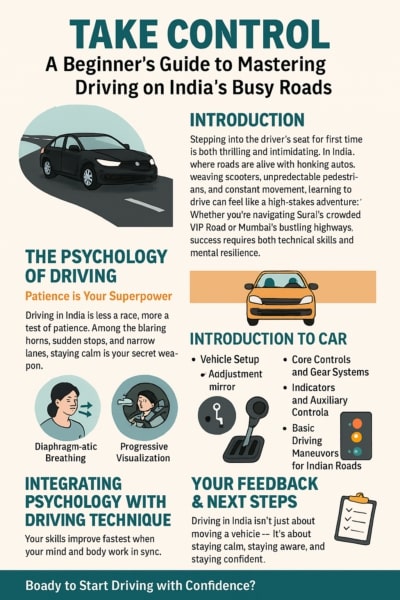Introduction: Embracing the Challenge of Indian Roads
Stepping into the driver’s seat for the first time is both thrilling and intimidating. In India, where roads are alive with honking autos, weaving scooters, unpredictable pedestrians, and constant movement, learning to drive can feel like a high-stakes adventure. Whether you’re navigating Surat’s crowded VIP Road or Mumbai’s bustling highways, success requires both technical skills and mental resilience.
At Drive With Confidence Driving School, our Beginners Driving Lessons (Basic) are designed to help you master car control and build psychological confidence to handle Indian traffic. This guide blends practical techniques with mindset strategies, empowering you to start your driving journey with clarity and control.
The Psychology of Driving: Patience is Your Superpower
Driving in India is less a race, more a test of patience. Among the blaring horns, sudden stops, and narrow lanes, staying calm is your secret weapon.
At Drive With Confidence, we believe every learner progresses at their own pace. We don’t compare—you grow in your own lane.
Common Beginner Fears:
Stalling at a signal Merging into fast-moving traffic Coordinating clutch, gear, and accelerator
We help you manage these fears using science-backed driving psychology techniques:
Diaphragmatic Breathing: Inhale for 4 seconds, hold for 4, exhale for 6. This reduces your heart rate and keeps you calm in stressful traffic situations. Progressive Visualization: Mentally rehearse gear shifting or turning at a busy junction to improve real-time performance. Countdown Technique: Use a mental “3-2-1” when releasing the clutch. This keeps you grounded during tricky maneuvers.
Remember: Stalling isn’t failure; it’s a step toward mastery.
Embracing mistakes with curiosity builds lasting confidence. Whether you’re stuck behind a rickshaw or navigating Delhi’s hectic intersections, a calm and focused mind will always steer you right.
Introduction to the Car: Technical Skills for Indian Roads
Learning the vehicle’s controls is the bedrock of driving confidently—especially in India’s complex traffic.
1. Vehicle Setup: Safety and Precision First
Seat Adjustment: Maintain a 100–120° knee angle to ensure smooth pedal control and reduce fatigue. Mirror Settings: Side mirrors should show just the car’s edge; rearview should fully frame the back window. Steering Grip: Hold the wheel at 9 and 3 o’clock for quick, precise maneuvers.
This ergonomic setup enhances your reaction time when dodging potholes, stray dogs, or fast-turning scooters.
2. Core Controls and Gear Systems
Most Indian vehicles are manual, and understanding the 5-speed H-pattern gear system is crucial.
1st Gear (0–15 km/h): Start the car or crawl through traffic. 2nd Gear (15–30 km/h): For slow-moving city roads. 3rd Gear (30–50 km/h): Comfortable for moderate urban traffic. 4th & 5th Gears (50+ km/h): For highways or open stretches.
Clutch Tip:
Hold the clutch at the bite point (when the car starts to move slightly) and gently press the accelerator to avoid jerky movements, especially in stop-and-go city traffic.
Braking Tip:
Apply progressive pressure—slow and steady over 3–5 seconds—for smooth, safe halts.
Accelerator Tip:
Use a light, consistent foot to maintain balance and avoid sudden jumps in traffic.
3. Indicators and Auxiliary Controls
Indicators are your communication tools—use them consistently:
Turn Signals: Activated by the stalk, they blink at 60–120 times per minute and signal your next move. Dashboard Lights: Confirm your indicator is working, especially important in dense traffic.
Headlights:
Use low beams in city traffic. Use high beams cautiously on unlit rural roads.
Wipers: Essential during monsoons. Adjust speeds as per rainfall intensity.
Speedometer & Fuel Gauge:
Monitor speed to stay within city limits (usually 40 km/h) and avoid running out of fuel in long jams.
Warning Lights:
Regularly check for engine oil, battery, or other alerts to ensure the car is roadworthy before you start.
4. Basic Driving Maneuvers for Indian Roads
Begin practicing in low-traffic areas, gradually moving to main roads. You’ll learn:
Starting Smoothly: Engage first gear and release the clutch gradually. Stopping Safely: Apply brakes gently to avoid jerks. Steering Right: Use the push-pull technique for tighter, controlled turns—ideal when navigating around hawkers or sudden obstacles.
Defensive Driving Habits:
Start cultivating these early:
Scan surroundings constantly. Be alert for sudden stops, animals, or swerving bikers. Anticipate others’ actions instead of assuming predictability.
Integrating Psychology with Driving Technique
Your skills improve fastest when your mind and body work in sync.
In a traffic jam? Use countdown breathing to stay composed. Feeling nervous about a merging scooter? Pause, breathe deeply, and refocus. Visualize every tricky maneuver before attempting it—whether shifting gears mid-turn or navigating a busy roundabout.
Break down complex tasks into steps. For example:
Shift gear ➝ Check mirror ➝ Signal ➝ Look over shoulder ➝ Merge.
This method avoids overwhelm and builds confidence with each successful move.
Your Feedback & Next Steps
Driving in India isn’t just about moving a vehicle—it’s about staying calm, staying aware, and staying confident.
We’d love to hear from you:
What part of learning to drive excites or worries you the most? Do you want blogs on parallel parking, roundabout navigation, or rainy-season driving? What’s your biggest psychological challenge on the road?
Let us know in the comments below!
Ready to Start Driving with Confidence?
Book your Beginners Driving Lesson today!
📍 Visit us:
Drive With Confidence Driving School
1111 International Wealth Centre, VIP Road, Surat, India
📞 Call: 7778080808 / 7779090909
💬 WhatsApp: 7778833333
🌐 Website: www.drivewithconfidence.com
The road is yours to conquer. Start your journey today.

